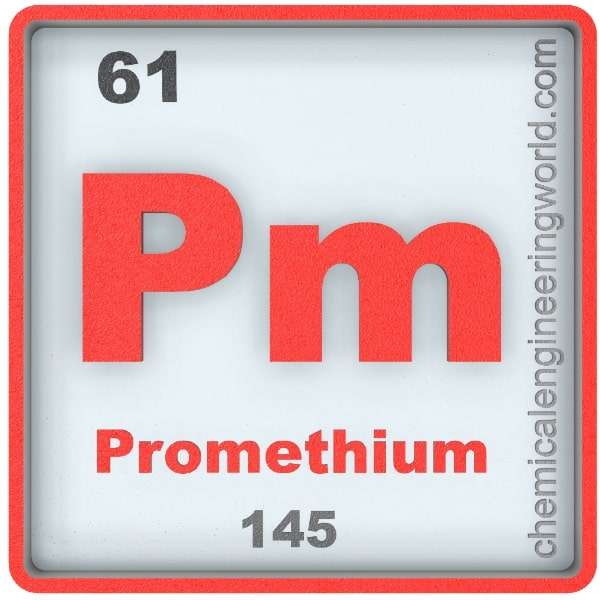Promethium Element Properties and Information

Promethium Element Properties and Information
Promethium is 61st element on the periodic table. Elements are arranged in the periodic table on the basis of the atomic number. Atomic number is the number of protons in the nucleus of the atom. Promethium has an atomic number of 61. It is located in the Group ‘Lanthanides’ and Period 6 of the periodic table of elements. It is denoted by ‘Pm’. The name is derived from ‘Prometheus’ of Greek mythology.
Bohuslav Branner speculated in 1902 that an element must exist which could be placed between neodymium and samarium. Many attempts were made over the years to find the element no. 61. It was found that a minute amount of this element of interest occurs in uranium ores, it was one of the fission products. Jacob .A. Marinsky, Lawrence E. Glendenin, and Charles D. Coryell separated promethium in 1945 from the fission products using ion-exchange chromatography.
Promethium is not found naturally on earth in extractable quantities, because all of its isotopes are radioactive. Its longest-lived isotope has half life of only 18 years. It was observed that a star in Andromeda galaxy manufactures promethium but the manufacturing mechanism is yet unknown.
Physical Properties
- Promethium is one among the two radioactive elements which are included with other stable-elements. The other one is technetium.
- The atomic mass of promethium is 147.
- The melting point of promethium is 1168°C.
- The boiling point of promethium is 2460°C.
- The density of promethium is 6475 in S.I. units at 20°C.
- Many properties of promethium are intermediate between neodymium and samarium.
- Below 890°C, promethium has double-hexagonal close-packed alpha structure. Above 890°C, promethium has a body-centered-cubic beta phase.
- Promethium-145 is the most stable isotope of promethium and it has half-life of about 18 years, 17.7 years to be exact.
Chemical Properties
- Promethium has not been properly studied due to its instability.
- Promethium compounds are observed to be existing only in +3 oxidation state.
- Promethium compounds have been observed to be pink or red in colour.
- Promethium compounds dissolve in hydrochloric acid to form trichloride and nitric acid to form corresponding nitrate compound.
Methods of Production
- Via Bombardment: Promethium-147 is the only industrially useful isotope of promethium. One way in which it is produced is by bombarding uranium-235 with thermal neutrons, this method produces the said isotope in large quantities. Another way is to bombard uranium-238 with fast neutrons to cause fast fission, promethium-147 is one among the multiple fission products obtained.
- Through Neodymium-147: Neodymium-147 decays to promethium-147. Neodymium-147 itself is obtained by bombardment.
Relevance in Chemical and Related Industries
Signal Lights: Some signal lights use a luminous paint, it contains phosphor. The phosphor absorbs beta radiation emitted by promethium-147 thus emitting a color.
Relevance in Other Industries
- Atomic Batteries: A promethium source is placed between two semiconductor plates, thus the beta particles emitted by promethium are converted to electrical source.
- Measurement: Promethium can be used to measure thickness of materials. It is done by evaluating the amount of radiation from a promethium source which passes through the sample.
Health Effects on Exposure
Localisation: Promethium is a radioactive element; direct exposure to it is a danger to health and life. If it enters the body then it gets localized in bones.
Effects on Surroundings
- Promethium is practically non-existent in nature, only 500-600 grams appear in Earth’s crust at any given time. Thus it poses no threat to the environment.
References:
https://en.wikipedia.org/wiki/Promethium
































